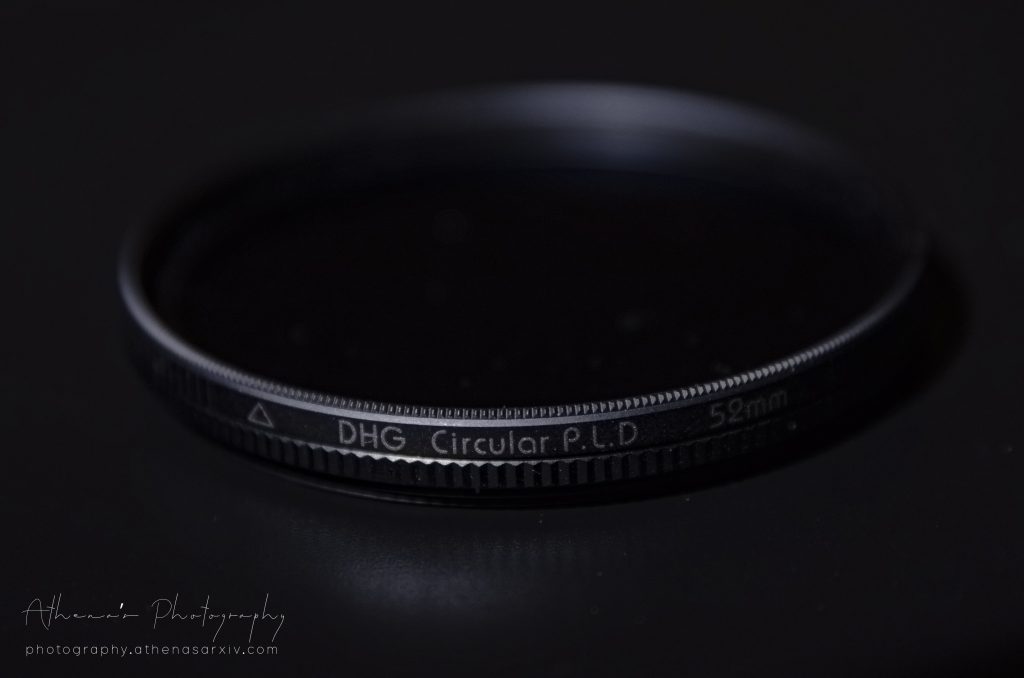UV Filter
These filters are made to block ultra violet (UV) rays from getting inside the lens. To be honest, these filters are the most useless filters available in the market since all modern lens have coatings which already blocks UV rays. This filter can be used as a protection glass, however, a lens hood offers enough protection to the front glass element. I have never used a UV filter in my life and most professional photographers do not use it either. In my opinion, degrading the quality of the image is the best thing a UV filter can do.
Circular Polariser (CPL)
The physics behind CPL is very interesting, but it is out of the scope of this chapter. If you are interested in digging into more scientific and technical details, refer to chapter Light: Polarisation and Diffraction. With a CPL, you can remove the surface reflections and this makes the image look more vibrant. You can easily cut the reflections in water or glass, which makes them look crystal clear. Here are a couple of examples, but you need to use it to to understand how amazing it is.

Neutral Density (ND) Filter
ND filters are nothing but just black glass. But they are expensive black glass. They stop the amount of light that can go through the lens, allowing to slow down the shutter speed, keeping other settings constant. This helps in creating smooth and milky waterfalls picture which you might have noticed in some landscape photos and this is just one use. You can get very creative with this glass. A good ND filter should not change the colour balance or tint of the image. So I always say – never buy cheap filters as cheap filters will only degrade your image.
ND filters are available in various ratings e.g. ND2, ND4, ND8 etc. These ratings will help you understand how much light the ND filter will let pass through it. ND2, ND4 and ND8 allows 1/2, 1/4th and 1/8th of the light respectively to pass through it, i.e., it reduces 1, 2, and 3 stops of light respectively. I have summarised the transmission capability of the most commonly used ND filters in the following table.
| ND filter rating | Stops of light reduction | Fraction of light transmission |
| ND2 | 1 | 1/2 |
| ND4 | 2 | 1/4 |
| ND8 | 3 | 1/8 |
| ND16 | 4 | 1/16 |
| ND32 | 5 | 1/32 |
| ND64 | 6 | 1/64 |
| ND128 | 7 | 1/128 |
| ND256 | 8 | 1/256 |

Graduated Neutral Density (GND) Filter
Graduated ND filter is more or less like ND filter. The only difference is that the light transmission capabilities of the filters gradually varies from one end of the filter to the other. They are particularly useful during sunset where the light above the horizon is partially blocked, but the light below the horizon is allowed to pass.
Variable Neutral Density (VND) Filter
Variable ND filter is the same as a ND filter in terms of functionality but the main difference is that in a variable ND filter, the light transmission capabilities can be changed by rotating the front ring of the filter. It is more versatile than the ND filter as it is a single filter that can replace multiple ND filters with different ratings. It is to be noted that there can be significant colour balance shift with variable ND filters. I personally do not prefer using them.
Close-up Filter
Close-up filters are very similar to magnifying glasses. They act as a magnifier and are also capable of reducing the minimum focusing distance. These filters are mainly used for macro photography.
IR Pass Filter
IR pass filters or IR filters blocks the light from the visible range and lets the infra red waves pass through it. A 720nm IR filters blocks all light waves below 720nm and a 950nm IR filter blocks all wavelengths below 950nm. They can be used with any cameras, but for best results, use the IR filter with a full spectrum modified camera. These lens filters can produce dreamy surreal images.

Ultra High Contrast (UHC) Filter
As the name suggests, UHC filters offer superb contrast and are mainly used for astro-photography. In case you are wondering, astro-photography is the photography that involves photographing the astronomical bodies like planets, galaxies, nebulae etc.
Light Pollution Filter
Light pollution filters try to reduce the light pollution typically found in urban environments. These lights are mostly used during photographing the night sky. The effectiveness of this filter is debatable, however, I personally believe from my experience that the expensive ones make slight difference.
Special Effects Filter
Special effects lens filters are not very widely used these days since a lot of things can be done in post processing of the photograph. These filters can add various artistic effects to the photograph. For example star effects filters add a star-like effect on the lights in the photograph. Other filters like warming filter and cooling filter can change the temperature of the photo by adding a warm tone or cool tone respectively. There are many other special effects filter, but I am not going through all of them as they are not important in this generation of digital photos. If you are interested, you can google it and get an idea of different special effects filter.
